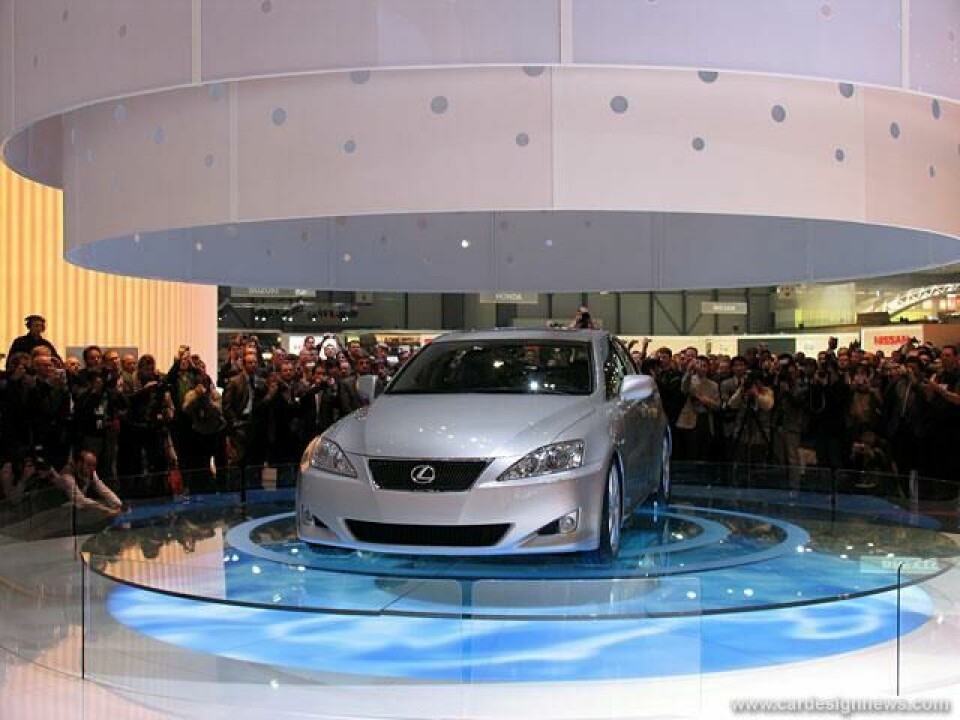
Design Review: Lexus IS
First impressions are of a scaled-down version of last year’s luxury GS-Series, featuring clean surfaces and a high beltline.The proportions are based on an interesting concept, according to Lexus: the front axle to windshield base equals the rear axle to rear screenbase, giving a characteristic ‘long cabin proportion’ set well back on the body
The old IS200/300 was a simple concept, clearly targeted at the BMW 3 Series: a sporty, compact executive car with a straight-six engine and RWD, available in sedan or sporty wagon format. This new model is a much more complex product, in some ways more mainstream, in others more sophisticated and focused. The new design direction is meant to express three fundamental elements of the Lexus ‘L-Finesse’ design philosophy: ‘Incisive Simplicity’ - perhaps best explained as purity, ‘Intriguing Elegance’ - a sense of depth that appeals to the emotions, and ‘Seamless Anticipation’ - part and parcel of traditional Japanese hospitality wherein the anticipation of an event is fundamental to its ultimate enjoyment.
Communicating those values could be difficult in, what appears to be, an understated style. In many ways, the last thing this segment needs is another understated car.
However, an unashamedly modern car, in tune with a lot of young executives’ tastes, not weighed down by the ‘heritage baggage’ of so many European premium brands, could work, and this is the approach taken by Lexus with the new IS-Series.
The concept of the car has also shifted from ‘compact sporting’ to a more luxury-orientated theme, which appears to be the drift of this sector of the market nowadays. To meet those aims, the new Lexus is 90 mm longer and 75 mm wider than its predecessor with a further 60 mm in the wheelbase to provide generous cabin space.
First impressions are of a scaled-down version of last year’s luxury GS-Series, featuring clean surfaces and a high beltline.The proportions are based on an interesting concept, according to Lexus: the front axle to windshield base equals the rear axle to rear screenbase, giving a characteristic ‘long cabin proportion’ set well back on the body. The side DLO and C-pillar is also said to be inspired by a symbol of traditional Japanese culture that expresses dynamism: ‘Kirikaeshi’ describes a rapid, yet fluid change of direction, creating an analogy to Japanese calligraphy or the movement of a samurai sword. This will become a further key styling element to the Lexus marque in future.
The front and rear corners of the car have very complex combinations of convex and concave surfaces that certainly meet the brief of ‘Intriguing Elegance’. In contrast, the side profile bodyside is clean but surprisingly plain, with all the surface interest contained either up in the shoulder area or down in the sill. The wheelarches are also pulled tightly (too tightly?) around the tyres to anchor the car to the ground. Also on the negative side, the cliff face of a rear bumper is very heavy-looking and the taillamps seem a little plain, even dated. And why are its ears (door mirrors) so big?!






The old IS200/300 was a simple concept, clearly targeted at the BMW 3 Series: a sporty, compact executive car with a straight-six engine and RWD, available in sedan or sporty wagon format. This new model is a much more complex product, in some ways more mainstream, in others more sophisticated and focused. The new design direction is meant to express three fundamental elements of the Lexus ‘L-Finesse’ design philosophy: ‘Incisive Simplicity’ - perhaps best explained as purity, ‘Intriguing Elegance’ - a sense of depth that appeals to the emotions, and ‘Seamless Anticipation’ - part and parcel of traditional Japanese hospitality wherein the anticipation of an event is fundamental to its ultimate enjoyment.
Communicating those values could be difficult in, what appears to be, an understated style. In many ways, the last thing this segment needs is another understated car.







